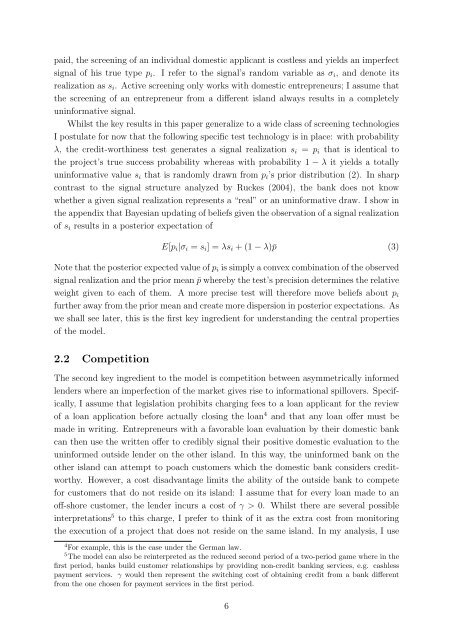Bank Competition, Information Choice and Inefficient Lending Booms
Bank Competition, Information Choice and Inefficient Lending Booms
Bank Competition, Information Choice and Inefficient Lending Booms
Create successful ePaper yourself
Turn your PDF publications into a flip-book with our unique Google optimized e-Paper software.
paid, the screening of an individual domestic applicant is costless <strong>and</strong> yields an imperfect<br />
signal of his true type p i . I refer to the signal’s r<strong>and</strong>om variable as σ i , <strong>and</strong> denote its<br />
realization as s i . Active screening only works with domestic entrepreneurs; I assume that<br />
the screening of an entrepreneur from a different isl<strong>and</strong> always results in a completely<br />
uninformative signal.<br />
Whilst the key results in this paper generalize to a wide class of screening technologies<br />
I postulate for now that the following specific test technology is in place: with probability<br />
λ, the credit-worthiness test generates a signal realization s i = p i that is identical to<br />
the project’s true success probability whereas with probability 1 − λ it yields a totally<br />
uninformative value s i that is r<strong>and</strong>omly drawn from p i ’s prior distribution (2). In sharp<br />
contrast to the signal structure analyzed by Ruckes (2004), the bank does not know<br />
whether a given signal realization represents a “real” or an uninformative draw. I show in<br />
the appendix that Bayesian updating of beliefs given the observation of a signal realization<br />
of s i results in a posterior expectation of<br />
E[p i |σ i = s i ] = λs i + (1 − λ)¯p (3)<br />
Note that the posterior expected value of p i is simply a convex combination of the observed<br />
signal realization <strong>and</strong> the prior mean ¯p whereby the test’s precision determines the relative<br />
weight given to each of them. A more precise test will therefore move beliefs about p i<br />
further away from the prior mean <strong>and</strong> create more dispersion in posterior expectations. As<br />
we shall see later, this is the first key ingredient for underst<strong>and</strong>ing the central properties<br />
of the model.<br />
2.2 <strong>Competition</strong><br />
The second key ingredient to the model is competition between asymmetrically informed<br />
lenders where an imperfection of the market gives rise to informational spillovers. Specifically,<br />
I assume that legislation prohibits charging fees to a loan applicant for the review<br />
of a loan application before actually closing the loan 4 <strong>and</strong> that any loan offer must be<br />
made in writing. Entrepreneurs with a favorable loan evaluation by their domestic bank<br />
can then use the written offer to credibly signal their positive domestic evaluation to the<br />
uninformed outside lender on the other isl<strong>and</strong>. In this way, the uninformed bank on the<br />
other isl<strong>and</strong> can attempt to poach customers which the domestic bank considers creditworthy.<br />
However, a cost disadvantage limits the ability of the outside bank to compete<br />
for customers that do not reside on its isl<strong>and</strong>: I assume that for every loan made to an<br />
off-shore customer, the lender incurs a cost of γ > 0. Whilst there are several possible<br />
interpretations 5 to this charge, I prefer to think of it as the extra cost from monitoring<br />
the execution of a project that does not reside on the same isl<strong>and</strong>. In my analysis, I use<br />
4 For example, this is the case under the German law.<br />
5 The model can also be reinterpreted as the reduced second period of a two-period game where in the<br />
first period, banks build customer relationships by providing non-credit banking services, e.g. cashless<br />
payment services. γ would then represent the switching cost of obtaining credit from a bank different<br />
from the one chosen for payment services in the first period.<br />
6
















